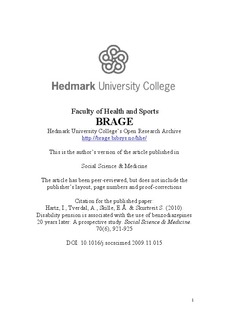Disability pension as predictor of later use of benzodiazepines among benzodiazepine users
Original version
Hartz, I., Tverdal, A., Skille, E.Å. & Skurtveit S. (2010). Disability pension is associated with the use of benzodiazepines 20 years later: A prospective study. Social Science & Medicine. 70(6), 921-925 http://dx.doi.org/10.1016/j.socscimed.2009.11.015Abstract
The proportion of Norwegians on disability pensions has doubled since the 1980s. The Norwegian Government wants action to stimulate the working capacity in those disability pensioners who have the potential to work. Information on factors that may impair rehabilitation efforts, including the unfavourable use of benzodiazepines, may be useful in this context. A longitudinal design, including data on 40–42 year old participants in Norwegian health surveys (year 1985–1989) linked to a prescription database (year 2004–2006), was used to describe risk of long-term use of benzodiazepines among disability pension recipients. The study population constituted benzodiazepine users at baseline.
More than half of those on disability pensions, 57% of all men and 65% of all women, retrieved benzodiazepine prescriptions 20 years later, a span covering a large part of the potential active workforce period. Further, the observed amount of benzodiazepines dispensed over a three-year period indicated more than sporadic use e.g. half of the female disability pensioners were dispensed an amount of benzodiazepines corresponding to the use of a daily dose every second day over a three year period (median 450 daily doses). The majority of those who were dispensed benzodiazepines, were dispensed opioids as well: half of all men and 3 out of four women. And last, being on a disability pension was a predictor of benzodiazepine use 20 years later.
Our study suggests that benzodiazepines are extensively and unfavourably used among disability pensioners, and that disability pension may have an independent effect on long-term use. Improved management of benzodiazepine use may be one alternative to get disability pensioners with the potential to work back into employment.
Description
The original publication is available at: http://dx.doi.org/10.1016/j.socscimed.2009.11.015
